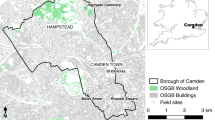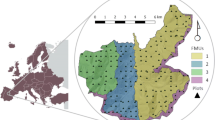Abstract
Small Footprint LiDAR (Light Detection And Ranging) has been proposed as an effective tool for measuring detailed biophysical characteristics of forests over broad spatial scales. However, by itself LiDAR yields only a sample of the true 3D structure of a forest. In order to extract useful forestry relevant information, this data must be interpreted using mathematical models and computer algorithms that infer or estimate specific forest metrics. For these outputs to be useful, algorithms must be validated and/or calibrated using a sub-sample of ‘known’ metrics measured using more detailed, reliable methods such as field sampling. In this paper we describe a novel method for delineating and deriving metrics of individual trees from LiDAR data based on watershed segmentation. Because of the costs involved with collecting both LiDAR data and field samples for validation, we use synthetic LiDAR data to validate and assess the accuracy of our algorithm. This synthetic LiDAR data is generated using a simple geometric model of Loblolly pine (Pinus taeda) trees and a simulation of LiDAR sampling. Our results suggest that point densities greater than 2 and preferably greater than 4 points per m2 are necessary to obtain accurate forest inventory data from Loblolly pine stands. However the results also demonstrate that the detection errors (i.e. the accuracy and biases of the algorithm) are intrinsically related to the structural characteristics of the forest being measured. We argue that experiments with synthetic data are directly useful to forest managers to guide the design of operational forest inventory studies. In addition, we argue that the development of LiDAR simulation models and experiments with the data they generate represents a fundamental and useful approach to designing, improving and exploring the accuracy and efficiency of LiDAR algorithms.









Similar content being viewed by others
References
Coulson RN, Stephen FM (2006) Impacts of insects in forest landscapes: Implications for forest health management. In: Paine TD (ed) Invasive forest insects, introduced forest trees, and altered ecosystems. Ecological pest management in global forest of a changing world. Springer, New York, pp 101–125
Zhao K, Popescu SC, Nelson RF (2009) Lidar remote sensing of forest biomass: a scale-invariant estimation approach using airborne lasers. Remote Sens Environ 113(1):182–196
Magnussen S, Boudewyn P (1998) Derivations of stand heights from airborne laser scanner data with canopy-based quantile estimators. Can J For Res 28(7):1016–1031
Lefsky MA, Harding D, Cohen WB, Parker G, Shugart HH (1999) Surface lidar remote sensing of basal area and biomass in deciduous forests of Eastern Maryland, USA. Remote Sens Environ 67(1):83–98
Means J, Acker S, Fitt B, Renslow M, Emerson L, Hendrix C (2000) Predicting forest stand characteristics with airborne scanning lidar. Photogramm Eng Remote Sens 66(11):1367–1371
Naesset E (1997) Estimating timber volume of forest stands using airborne laser scanner data. Remote Sens Environ 61(2):246–253
Anderson MC, Neale CMU, Li F, Norman JM, Kustas WP, Jayanthi H, Chavez J (2004) Upscaling ground observations of vegetation water content, canopy height, and leaf area index during SMEX02 using aircraft and Landsat imagery. Remote Sens Environ 92(4):447–464
Jensen JLR, Humes KS, Vierling LA, Hudak AT (2008) Discrete return lidar-based prediction of leaf area index in two conifer forests. Remote Sens Environ 112(10):3947–3957
Zhang K (2008) Identification of gaps in mangrove forests with airborne LIDAR. Remote Sens Environ 112(5):2309–2325
Hyyppä J, Hyyppä H, Litkey P, Yu X, Haggrén H, Rönnholm P, Pyysalo U, Pitkanen J, Maltamo M (2004) Algorithms and methods of airborne laser-scanning for forest measurements. In: Thies M, Koch B, Spiecker H, Weinacker H (eds), Laser-Scanners for Forest and Landscape Assessment: Proceedings of the ISPRS Working Group VIII/2, Freiburg, Germany, 3–6 October
Lim K, Treitz P, Wulder M, St-Onge B, Flood M (2003) LiDAR remote sensing of forest structure. Prog Phys Geogr 27(1):88–106
Popescu SC, Wynne RH, Nelson RF (2002) Estimating plot-level tree heights with lidar: local filtering with a canopy-height based variable window size. Comput Electron Agric 37(1):71–95
Anderson HE (2009) Using airborne Light Detection and Ranging (LIDAR) to characterize forest stand condition on the Kenai Penisula of Alaska. West J Appl For 24:95–102
Rahman MZA, Gorte B Individual Tree Detection Based on Densities of High Points of High Resolution Airborne LiDAR. In: Hay GJ, Blaschke T, Marceau D (eds) GEOBIA 2008 – Pixels, Objects, Intelligence. GEOgraphic Object Based Image Analysis for the 21st Century, Calgary Alberta, Canada, 2008. International Society for Photogrammetry and Remote Sensing (ISPRS), pp 350–355
Yang L, Wu X, Ma X (2009) Tree detection from aerial imagery. In: ACM GIS ‘09, Seattle, WA, USA, November 4–6
Kasischke ES, Christensen NL Jr, Haney E (1994) Modelling of geometric properties of loblolly pine tree and stand characteristics for use in radar backscatter models. IEEE Trans Geosci Remote Sens 32:800–822
Wehr A, Lohr U (1999) Airborne laser scanning—an introduction and overview. J Photogramm Remote Sens 54:68–82
Habib AF, Bang KI, Kersting A, Lee DC (2009) Error budget of LiDAR systems and quality control of the derived data. Photogramm Eng Remote Sens 75(9):1093–1108
Baltsavias EP (1999) Airborne laser scanning: basic relations and formulas. ISPRS J Photogramm Remote Sens 54(3):199–214
Sun G, Ranson KJ (2000) Modeling lidar returns from forest canopies. IEEE Trans Geosci Remote Sens 38(6):2617–2626
Chen DBQ, Gong P, Kelly M (2006) Isolating individual trees in a savanna woodland using small footprint lidar data. Photogramm Eng Remote Sens 72:923–932
Kwak DA, Lee WK, Lee JH, Biging GS, Gong P (2007) Detection of individual trees and estimation of tree height using LiDAR data. J For Res 12(6):425–434
Schardt M, Ziegler M, Wimmer A, Wack R, Hyyppa J (2002) Assessment of forest parameters by means of Laser Scanning. Int Arch Photogramm Remote Sens Environ XXXIV(part 3A):302–309
Falkowski MJ, Smith AMS, Hudak AT, Gessler PE, Vierling LA, Crookston NL (2006) Automated estimation of individual conifer tree height and crown diameter via two-dimensional spatial wavelet analysis of lidar data. Can J Remote Sens 32(2):153–161
Clark ML, Clark DB, Roberts DA (2004) Small-footprint lidar estimation of sub-canopy elevation and tree height in a tropical rain forest landscape. Remote Sens Environ 91(1):68–89
Eckstein BA (1989) Evaluation of spline and weighted average interpolation algorithms. Comput Geosci 15(1):245–257
Hutchinson MF, Gessler PE (1994) Splines - more than just a smooth interpolator. Geoderma 62:45–67
Kitanidis PK (1997) Introduction to geostatistics. Cambrsidge University Press
Oliver MA (1990) Kriging: a method for interpolation for Geographical Information Systems. Int J Geogr Inf Syst 4:313–332
Phillips DL, Dolph J, Marks D (1992) A comparison of geostatistical procedures for spatial analysis of precipitations in mountainous terrain. Agr Forest Meterol 58:119–141
Voltz M, Goulard M (1994) Spatial interpolation of soil moisture retention curves. Geoderma 62:109–123
Tabios GQ, Salas JD (1985) A comparative analysis of techniques for spatial interpolation of precipitation. Wat Resour Bull 21(3):365–380
Liu H, Wang L, S-j T, Jezek K (2011) Robust multi-scale image matching for deriving ice surface velocity field from sequential satellite images. Int J Remote Sens 24(7):1015–1041
Yang C-S, Kao S-P, Lee F-B, Hung P-S (2004) Twelve different interpolation methods: A case study of Surfer 8.0. In: Proceedings of the XXth ISPRS Congress. pp 778–785
Bieniek A, Moga A (2000) An efficient watershed algorithm based on connected components. Pattern Recogn 33:907–916
Soille P (1999) Morphology image analysis. Springer, Berlin
Meyer F, Beucher S (1990) Morphological segmentation. J Vis Commun Image Represent 1:21–46
Popescu SC (2007) Estimating biomass of individual pine trees using airborne lidar. Biomass Bioenergy 31(9):646–655
Maltamo M, Eerikäinen K, Pitkänen J, Hyyppä J, Vehmas M (2004) Estimation of timber volume and stem density based on scanning laser altimetry and expected tree size distribution functions. Remote Sens Environ 90(3):319–330
Persson A, Holmgren J, Soderman U (2002) Detecting and measuring individual trees using an airborne laser scanner. Photogramm Eng Remote Sens 68(9):925–932
Morsdorf F, Meier E, Kotz B, Itten KI, Dobbertin M, Allgwaer B (2004) LIDAR-based geometric reconstruction of boreal type forest stands at single tree level for forest and wildland fire management. Remote Sens Environ 92(3):353–362
Brandtberg T (2007) Classifying individual tree species under leaf-off and leaf-on conditions using airborne lidar. ISPRS J Photogramm Remote Sens 61(5):325–340
Takahashi T, Yamamoto K, Miyachi Y, Senda Y, Tsuzuku M (2006) The penetration rate of laser pulses transmitted from a small-footprint airborne lidar: a case study in closed-canopy, middle-aged pure sugi (Cryptomeria japonica D. Don) and hinoki cypress (Chamaecyparis obtusa Sieb. et Zucc.) stands in Japan. J For Res 11:117–123
Suarez JC, Ontiveros C, Smith S, Snape S (2005) Use of airborne LiDAR and aerial photography in the estimation of individual tree heights in forestry. Comput Geosci 31(2):253–262
Popescu SC, Wynne RH, Nelson RF (2003) Measuring individual tree crown diameter with lidar and assessing its influence on estimating forest volume and biomass. Can J Remote Sens 29:564–577
Lovell JL, Jupp DLB, Newnham GJ, Coops NC, Culvenor DS (2005) Simulation study for finding optimal LiDAR acquisition parameters for forest height retrieval. For Ecol Manag 214(1–3):398–412
Goodwin NR, Coops NC, Culvenor DS (2007) Development of a simulation model to predict LiDAR interception in forested environments. Remote Sens Environ 111(4):481–492
Ni-Meister W, Jupp DLB, Dubayah R (2001) Modeling LiDAR waveforms in heterogeneous and discrete canopies. IEEE Trans Geosci Remote Sens 39(9):1943–1958
Koetz B, Morsdorf F, Sun G, Ranson KJ, Itten K, Allgower B (2006) Inversion of a LiDAR waveform model for forest biophysical parameter estimation. Geosci Remote Sens Lett IEEE 3(1):49–53
García R, Suárez JC, Patenaude G (2007) Delineation of individual tree crowns for LiDAR tree and stand parameter estimation in Scottish woodlands. In: Fabrikant SI, Wachowicz M (eds) The European information society: Leading the way with geo-information. Lecture notes in geoinformation and cartography. Springer, Berlin, pp 55–85
Hirata Y (2004) The effects of footprint size and sampling density in airborne laser scanning to extract individual trees in mountainous terrain. In: SPRS working group 8/2 Laser-Scanners for Forest and Landscape Assessment, Freiburg, Germany. pp 102–107
Goodwin NR, Coops NC, Culvenor DS (2006) Assessment of forest structure with airborne LiDAR and the effects of platform altitude. Remote Sens Environ 103:140–152
Lefsky MA, Harding DJ, Keller M, Cohen WB, Carabajal CC, Espirito-Santo FDB, Hunter MO, de Oliveira R Jr (2005) Estimates of forest canopy height and aboveground biomass using ICESat. Geophys Res Lett 32:L22S02
Ioki K, Imanishi J, Sasaki T, Morimoto Y, Kitada K (2010) Estimating stand volume in broad-leaved forest using discrete-return LiDAR: plot-based approach. Landsc Ecol Eng 6(1):29–36. doi:10.1007/s11355-009-0077-4
Beets PN, Reutebuch S, Kimberley MO, Oliver GR, Pearce SH, McGaughey RJ (2011) Leaf area index, biomass carbon and growth rate of radiata pine genetic types and relationships with LiDAR. Forests 2:637–659
Ni-Meister W, Lee S, Strahler AH, Woodcock CE, Schaaf C, Yao T, Ranson KJ, Sun G, Blair JB (2010) Assessing general relationships between aboveground biomass and vegetation structure parameters for improved carbon estimate from lidar remote sensing. J Geophys Res 115:G00E11
Author information
Authors and Affiliations
Corresponding author
Rights and permissions
About this article
Cite this article
Wang, L., Birt, A.G., Lafon, C.W. et al. Computer-based synthetic data to assess the tree delineation algorithm from airborne LiDAR survey. Geoinformatica 17, 35–61 (2013). https://doi.org/10.1007/s10707-011-0148-1
Received:
Revised:
Accepted:
Published:
Issue Date:
DOI: https://doi.org/10.1007/s10707-011-0148-1




